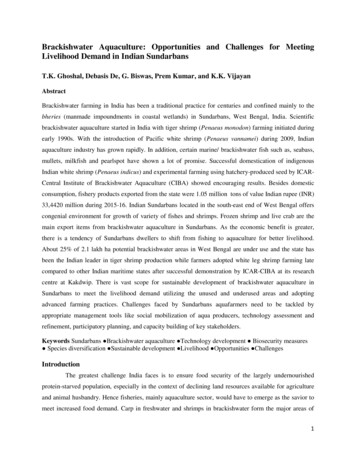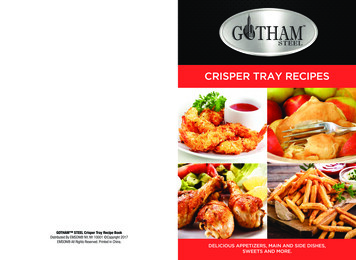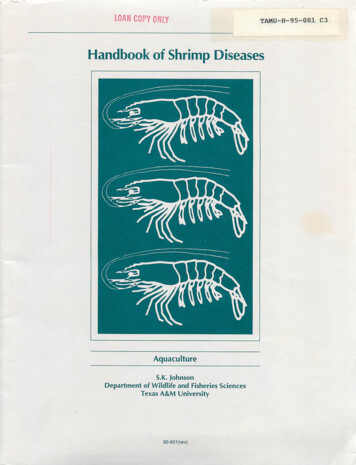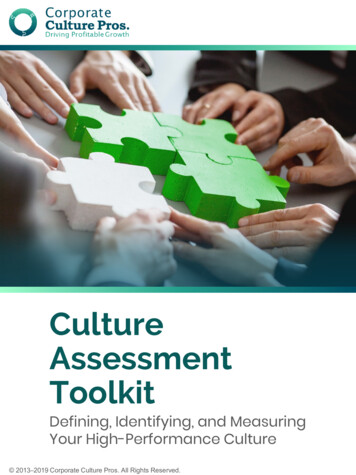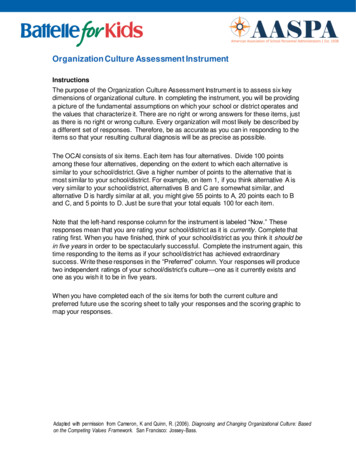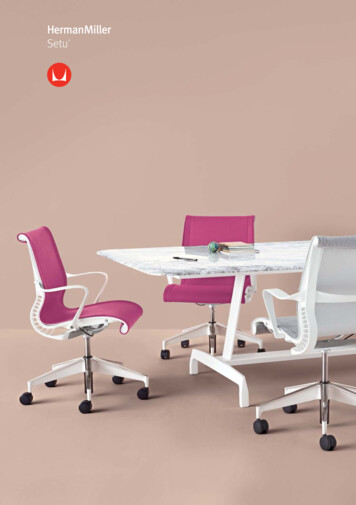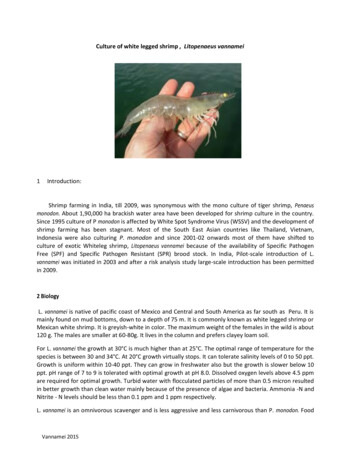
Transcription
Culture of white legged shrimp , Litopenaeus vannamei1Introduction:Shrimp farming in India, till 2009, was synonymous with the mono culture of tiger shrimp, Penaeusmonodon. About 1,90,000 ha brackish water area have been developed for shrimp culture in the country.Since 1995 culture of P monodon is affected by White Spot Syndrome Virus (WSSV) and the development ofshrimp farming has been stagnant. Most of the South East Asian countries like Thailand, Vietnam,Indonesia were also culturing P. monodon and since 2001-02 onwards most of them have shifted toculture of exotic Whiteleg shrimp, Litopenaeus vannamei because of the availability of Specific PathogenFree (SPF) and Specific Pathogen Resistant (SPR) brood stock. In India, Pilot-scale introduction of L.vannamei was initiated in 2003 and after a risk analysis study large-scale introduction has been permittedin 2009.2 BiologyL. vannamei is native of pacific coast of Mexico and Central and South America as far south as Peru. It ismainly found on mud bottoms, down to a depth of 75 m. It is commonly known as white legged shrimp orMexican white shrimp. It is greyish-white in color. The maximum weight of the females in the wild is about120 g. The males are smaller at 60-80g. It lives in the column and prefers clayey loam soil.For L. vannamei the growth at 30 C is much higher than at 25 C. The optimal range of temperature for thespecies is between 30 and 34 C. At 20 C growth virtually stops. It can tolerate salinity levels of 0 to 50 ppt.Growth is uniform within 10-40 ppt. They can grow in freshwater also but the growth is slower below 10ppt. pH range of 7 to 9 is tolerated with optimal growth at pH 8.0. Dissolved oxygen levels above 4.5 ppmare required for optimal growth. Turbid water with flocculated particles of more than 0.5 micron resultedin better growth than clean water mainly because of the presence of algae and bacteria. Ammonia -N andNitrite - N levels should be less than 0.1 ppm and 1 ppm respectively.L. vannamei is an omnivorous scavenger and is less aggressive and less carnivorous than P. monodon. FoodVannamei 2015
intake is more during evening and night. Retention time of food in the gut is 2.2 to 5 hours. Growth of L.vannamei, under confined culture conditions is similar to P monodon till they attain 20g size. Beyond thatthe growth rate was poor. The shrimps attained the size of 20g within a period of 100-120 days dependingon the stocking density.3 Advantages of L. vannamei : Culture of L. vannamei, is being taken up in many countries because of thefollowing c characteristics: –1. It grows as fast as P. monodon upto 20 g.2.It is easier to culture in very high stocking densities of upto 150/sqm due to their less aggressivenature.3.It is tolerant to wide range of salinities of 0.5 to 45 ppt .4. It is very tolerant to low temperatures of upto 15 degree centigrade5. It requires comparatively low protein feed (20-35%).6. It is an easy to breed species and hence domestication of the species is very successful with theproduction of SPF stock. Commercial availability of SPF/SPR and High-health stock is an addedadvantage.7. Selective breeding work for the production of SPR brood stock is easier because of the shortgeneration period and easier captive breeding.8. Higher survival rates in hatchery (50-60%).9. Has a very good market in the US, as the most preferred species with higher meat yield (6668%).4 Disadvantages of L. vannamei : The above advantages make L. vannamei a very important cultivablespecies, however, the following disadvantages create some apprehension for its introduction in thecountry:1. L. vannamei is highly susceptible to and a carrier of TSV, WSSV, YHV, IHHNV and LOVV.Though SPF stocks are available for these viruses, the performance of these in the virusladden environment is doubtful. WSSV is prevalent in the country and its infectivity andpathogencity for L. vannamei is similar to that of P. monodon (Tapay et al. 1997)2. L. vannamei is being cultured in very high densities under intensive management, whichmight lead to environment problems like nutrient loading.3. L. vannamei is highly susceptible to hypoxic conditions and hence there is a need forcontinuos aeration during high density farming.4. Handling, processing and transporting are more difficult in L. vannamei compared Penaeusmonodon.5. There is high competition in the International market due to the world -wide production.Vannamei 2015
5 Specific pathogen Free Stock:L. vannamei is highly susceptible to a number of viral pathogens. White Spot Syndrome virus (WSSV),Taura Syndrome Virus (TSV), Yellow Head Virus (YHV), Infectious Hypodermal Haematopoietic NecrosisVirus (IHHNV), Lymphoid Organ Vacuolization Virus (LOW), Reo like Viruses (REO) are some of theviruses reported in the species. In order to eliminate the presence the virus in the seed, SpecificPathogen Free (SPF) stock has been developed by producing a number of generations in highly biosecure facility with continued surveillance of pathogen presence. Although SPF shrimp are, by definition,free of all specifically listed pathogens, SPF shrimp may be infected with a known pathogen that is notincluded on the SPF list of the shrimp supplier, or with an un-known pathogen that has not yet beendescribed. Offspring of SPF shrimp are not considered SPF unless they are produced and maintained atan SPF facility. SPF status changes with the pathogen condition of the shrimp, as well as the type ofenvironment within which they are cultured (Le. I level of biosecurity). One of the main advantages ofculturing L. vannamei is commercially available as high health animals from Specific Pathogen Free (SPF)stocks while P. monodon have very limited availability from SPF stocks.6 Bio – Security requirements of shrimp farms:Stocking of pathogen free post larvae alone will not guarantee a disease free culture since thepathogens still enter the culture environment horizontally and infect shrimps during the culture. Viralpathogens enter the culture pond through :1.2.3.4.5.By persisting in the soilIntake waterAquatic vectors introduced through intake water, by crabs and other animalsContaminated land animals and birdsContaminated farm inputs & farm implementsCrabs are one of the major carriers of viral pathogens and providing crab fencing in shrimp farms isconsidered as one of the important biosecurity measure. Carriers like crabs could also move from pondto pond over land barriers. To prevent such movements fencing made of 0.5 m plastic sheet should beput around culture pond.Birds such as crow/ water crow pick up the dead and moribund shrimps affected with viral disease fromponds and may drop unaffected ponds, there by transmitting the virus mechanically. This could beavoided by using bird scares and bird fencing over the pond.7 . Technical Parameters : Technical parameters of L vannamei culture include site selection, items ofpond development, pre and post stocking operations, stocking fertilisation, feeding harvesting andpost harvesting etc. are given in Annexure I8 . Margin:Vannamei 2015
The margin money may be considered @ 5, 10 & 15% for small, medium and large farmer respectivelyand 25% for companies and partnership firms.9. SubsidySubsidy may be available for various items like Pond Development, construction of New Ponds, firstyear inputs etc. under a centrally sponsored subsidy scheme implemented by majority of the StateGovernments through FFDA/ BFFDAs for different categories of farmers, details of which may beobtained from concerned Fisheries Departments/NFDB/MPEDA.10. Eligible BorrowersThe following category of borrowers are eligible to avail credit.a) An Individual.b) A company .c) A Partnership firm.d) A Co-operative society.e) A group of shrimp/fish farmers( SHGs/ JLGs)f) Producer Companies /OrganisationsTraining in fish farming is being provided by the FFDA/BFFDAs to the eligible borrowers and it is essentialthat the borrower has prior knowledge of fish /shrimp farming before availment of bank loan.11 . Financial Outlay :The details of Capital Cost and Recurring Cost have been indicated in Annexure II. The capital cost fordevelopment of one hectare pond works out to be Rs 8.48 lakh and the recurring cost as Rs 15.04 lakh.However, the cost is indicative and actual assessment of the cost parameters based on the field levelconditions have to be done while preparing /submitting the project to the bank.12. RepaymentRepayment of bank loan is possible in 6-8 years in annual instalments with moratorium on repayment ofprincipal for the first year. Annexure II13. Financial Analysis:As per financial analysis shown in annexure the scheme is financially viable. The financial parameters areas follows Annexure IIi). NPW @ 15% :Vannamei 2015Rs 30.03 lakh
ii). BCR @ 15% :1.18:1iii). IRR 50%:14. Rate of RefinanceNABARD provides refinance assistance for shrimp/fish culture to commercial banks, cooperative banksand Regional Rural Banks. The rate of refinance is fixed by NABARD from time to time.15. Rate of interestInterest rate to be charged to the ultimate borrowers would be as indicated by bank/RBI/NABARD fromtime to time depending on quantum of loan amount and the agency providing the loan.16. SecuritySecurity from the ultimate beneficiaries may be obtained as per the guidelines of RBI issued from timeto time.17. Registration of the FarmRegistration of the farm may be done as per the requirement of GoI/ State Governments .Technical Parameters Annexure I1.Farm Design Requirements:L.vannamei lives in the column and hence increasing the depth of the pond will help in increasing density.Generally shrimp farms which were culturing P. monodon had a water depth of about 1 mt. But isadvisable to have a depth of 1.5 to 1.8 m water column for culturing L. vannamei.Since mechanical aeration is one of the major requirements for L. vannamei culture due to higherstocking density, constant circulation of water is expected in the pond. This will lead to the erosion ofthe soil in the dyke and bottom. To avoid this compacting of the pond bottom and the dykes areessential. In intensive culture ponds total lining of the pond HDPE sheets is done to avoid any type ofVannamei 2015
erosion. In high density culture systems, accumulation of sludge in the bottom is a major problem andprovision of central drainage or use of sludge pumps is essential. Positioning of paddle wheel/long armaerators should aide in bringing the sludge to the centre of the pond from where it can be removed.Bio-security requirements like reservoir ponds, fencing, crab fencing bird fencing, and disinfectionfacilities are incorporated in the design. To avoid disease in most cases zero-water exchange system offarming is practiced with recirculation facilities. In such cases more than 40% of the water area in thefarm is allocated for reservoirs and waste sedimentation ponds.2 Management of the farm2. 1 Drying and LimingThe sludge left in the pond, may have the remains of the earlier viral disease outbreak , containinghigh organic load, bacteria, viral particles and DNA as well as many other viral carriers. All these shouldbe removed to prevent the persistence of viral disease. This could be achieved by the application ofburnt lime (CaO) @100 ppm, followed by exposure of the pond bottom to sunlight until drying andcracking, removal of the top soil and compacting the bottom soil2. 2 Water Management :White spot virus has been reported to survive as a free-living form in water up to seven days. Directuse of creek or sea water carries the risk of introducing the virus into the system. Most of the aquaticcrustaceans including the planktonic forms are reported to be carriers of WSSV virus. A number ofother aquatic organisms could be mechanical carriers because of their filter-feeding habit. There is aneed to eliminate these from water before use in culture ponds. Use of filter nets 60 micron mesh/sqcm in the delivery pipes/ inlet sluice should be strictly followed. Water should be taken in reservoirponds and treated with calcium hypochlorite @ 30 ppm and aged up to seven days, to eliminate theviral pathogens.Farmers should ensure that only treated water be used in the culture ponds for compensating theevaporation losses. Regular water exchange is not advised to avoid cross contamination pathogensfrom the source water.2.3. Fertilization and addition of carbon sourceCulture of L. vannamei can be done under two systems - with plankton as natural feed or withbacterial floc. The fertilization schedule with urea and superphosphate is followed for planktondevelopment while provision of carbon source in the form of molasses and dolomite is used fordevelopment of bacterial floc. The volume of bio-floc was controlled at 15 ml/ litre.2.4 . Stocking:SPF shrimp seed from a reputed approved hatchery may be used for stocking. PL8- PL9 is normallyselected after ensuring the pathogen free status of the seed. The seed acclimatization is a veryimportant requirement before stocking. Temperature, salinity and pH of the transportation waterVannamei 2015
should gradually brought to the level of pond water by gradual mixing of both over a period of 6-12hours depending on the difference. Stocking densities of 40 to 60 no/sq m is preferred. Higher stockdensities above 60 no./sq m is not permitted.2. 5 Feed Management:Protein requirement varies between 25 to 40% depending on the density. Marine source protein wasmore effective than plant source. Lipid requirement is around 6-8% with 2% marine unsaturated fattyacids and 0.25 to 0.4% of cholesterol. Feeding rate is between 6.6 to 16% for 1 gm of shrimp which willbe reduced to 2% for 15 gm shrimp. Optimal feeding frequency is between 2 and 6 in a day withmaximum percentage of feed distributed in the evening and night rations. Check trays are used tomonitor the feed consumption and the feeding ration is adjusted accordingly. FCR levels of 1.1 to 1.4 areexpected.2.6 Maintenance of Water Quality:Regular monitoring of water quality is very essential. Water quality parameters like temperature,salinity, pH and alkalinity are monitored on daily basis. DO levels are recorded at least 2 times a day.Other parameters like Ammonia, Nitrite, Calcium, Magnesium are monitored on weekly basis. DO levelsshould be maintained above 4 ppm although and operation of paddle wheel /long arm aerators shoulddone to maintain the level. The number of aerators required is about 1 HP per every 300 kg of mass. Thelocation of the aerators should be adjusted in such way the sedimentation occurs at centre of the pond,which will help in its easy removal.Removal of sludge from the pond bottom during culture is essential in case of high density. Aerators arepositioned in such a way that the sludge is accumulated in the center of the pond and from there itcould be removed through central drainage or using sludge pumps. To aid in the process, sludge settledin other places should be disturbed regularly. This is achieved through dragging of chains at the bottomat regular intervals on all sides of the pond2.7. Health Management:Weekly monitoring of shrimps for their growth and well being is essential. L. vannamei normally growsat the rate of 0.2gm /day after the first 30 days. Weekly growth rate will range between 1.5 to 2.0 gmdepending on the stocking density. At 60nos./m2 the shrimps attain 20g size within100 -120 days.3.0 . Harvest and Post HarvestVannamei 2015
L. vannamei is a column living shrimp and hence maximum stock can be harvested by either by cast netsor drag netting and this will help in harvesting without much overcrowding or stress. Final harvesting bydraining the water should be done within 6 hours. Compared to P. monodon, L. vannamei discoloursfaster if there is any delay in icing the harvested stock. Hence the stock should be 'ice killed'immediately on harvest and stored in ice.4. Cost of production:The cost of production of L. vannamei in Indian conditions considering the industrial rate for electricitymight work out to Rs. 150 -160 for production levels of 8 to 10 tons per ha. Theaverage size at harvest ranges from 20 to 25 g and the sale price is more or less samefor both P. monodon and L. vannamei of similar size at Rs. 200 to 220. The profit margin is very high andeven if only 50% of the area will be utilized for grow-out, it is beneficial than P. monodon culture.5. Conclusion:L.vannamei is very suitable species for semi-intensive culture with the availability of pathogen free seed.The major issues to be considered are bio-security and maintenance of water quality through constantmonitoring. It also requires higher technical knowledge to achieve higher production in sustainablemanner. Strict adherence to the guidelines of Coastal Aquaculture Authority is a must to ensureenvironment protection.Vannamei 2015
Annexure II Unit Cost Lvannamei culture 1 ha ModelAB123CAPITAL COSTEarthwork for construction ofponds by machinery ( usingProclaine)Water inlet structures for pondWater outlet structures forpondsMain outlet sluicesPump houseOffice, laboratory and storesWatchman shedPumpLong arm AeratorsElectrical installations/PowerSupply incl TransformerReservoirCrab FencingBird scare/ Bird netLab and farm equipment, pHmeter , salinometer , chemicalsetcMiscellaneous expenditureTOTAL --- AOperational cost for first cropStocking densityCost of PL20('000)Feed456Chemicals and manures forpond preparationElectricity/Power chargesRepairs and maintenance7Harvesting charges8Farm Supervisor1234567891011121314159 Mechanic/ skilled labour10 WatchmanVannamei 2015UnitQtyRate(Rs)Amount inRshaNos40 hr11500/ hr150006000015000NosNoSqftSqftsqft5 HP2HP11100350100141500035000300/sqft300/ 000140000LShrRMTSq 0005000001487500.75/ 500/month5000/10625per kg112400002600040000
Office expenses and misc11 expensesTOTAL --- BGrand Total (A B)monthsmonthLS25000LS2500015041252351625Means of Finance12345123412345678Total Financial outlayMargin 15%Financial AssistanceSay in Rs LakhRate of Interest2351625352744199888119.9912%Production and Income in RsProduction from 1 crop (kg) in 1haPrice per kgTotal income from 2 crops fromII yrOperational cost one cropAssumptionsFarm size (water spread area)haculture periodMonthsStocking rate 50 No / sqm10000sqmsurvival rateNo of pieces at harvestHarvest size( average)gmProductionkg/ha/cropWater exchange9 Feed10 No of crops per year11 FCRFinancial Analysis - Litopeneaus vannamei culture - 1 Ha ModelYearCapital CostRecur ring CostTotal CostGross BenefitNet Benefit (B-C)Present Worth of Costs at 15% DFVannamei 201518.4815.0423.5218.59-4.922-8 oFCR 1:1.40
Present Worth of Benefit at 15% DF196.71Net Present Worth (PW Benefit - PW Cost)30.03Benefit Cost Ratio (PW of Benefit / PW of Costs)Internal Rate of Return1.18 50%Repayment schedule – Litopeneaus vannamei 1 Ha ModelTotal financial OutlayMargin @ 15%Financial Assistance23.523.5319.99YearB/L O/S atthebeginning ofthe .343.557.117.117.117.117.117.11Vannamei 2015InterestPrincipalTotalBank loanO/s at theend of .133.340.403.343.740.00Repayment period 7 years with one year 01.241.331.441.571.721.90
Culture of white legged shrimp , Litopenaeus vannamei 1 Introduction: Shrimp farming in India, till 2009, was synonymous with the mono culture of tiger shrimp, Penaeus monodon. About 1,90,000 ha brackish water ar
